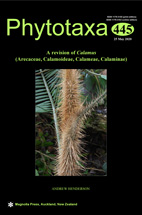Abstract
A revision of Calamus was carried out based on morphological data. Eight thousand, six hundred and thirty-three herbarium specimens were examined and scored for 14 quantitative and 157 qualitative variables. Application of the Phylogenetic Species Concept to 516 preliminary species of Calamus resulted in recognition of 411 phylogenetic species. Of these, 38 are recognized as new (C. barisanensis, C. brevissimus, C. brunneus, C. calciphilus, C. densifloropsis, C. disjunctus, C. divergens, C. exiguus, C. furvus, C. gaharuensis, C. goramensis, C. heteracanthopsis, C. hosensis, C. impressus, C. insolitus, C. insularis, C. johanis, C. kinabaluensis, C. kubahensis, C. latus, C. lengguanii, C. lobatus, C. notabilis, C. obiensis, C. oresbiopsis, C. oxleyoides, C. pahangensis, C. powlingii, C. saltuensis, C. seropakensis, C. spinosus, C. sulawesiensis, C. tambingensis, C. tapanensis, C. trigynus, C. vinaceus, C. viridis, C. wedaensis). Analysis of quantitative variables and geographic distributions resulted in the division of 11 species into 36 subspecies. Eight species were considered to be ochlospecies (C. erioacanthus, C. inermis, C. javensis, C. melanochaetes, C. micranthus, C. moseleyanus, C. plicatus, C. siphonospathus). Nomenclature, descriptions, and distribution maps are provided for all species. Images of the type specimens of all new species are provided as well as images of most qualitative variables. One hundred and forty–three species are illustrated with images from living plants.

